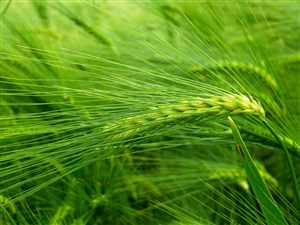Barley grass (Hordeum murinum subsp., leporinum)
Main Facts about Barley grass

Using Barley grass
Barley has natural steroids with no side effects and lots of vitamins, minerals and trace minerals needed for the formation of bones, tendons, ligaments and cartilage. Has 11 times more calcium than milk, more iron than spinach, more vitamin C than orange juice, and even has some B12. Barley grass, a popular ingredient in juice supplements, is rich in cholorophyll and antioxidants. One of the best sources of slow-burning long-lasting carbohydrate energy. Take a bunch 45 min before going to gym. Barley may help control appetite by stabilizing blood sugar and by slowing the emptying of your stomach. Barley contains beta glucan, a type of fiber that may help reducing total cholesterol and LDL "bad" cholesterol. It may also lower triglycerides and increase HDL "good" cholesterol levels, but the research has been mixed. Barley may also lower blood pressure in people who do not have high blood pressure but do have high cholesterol. Cool barley water is used in drinks for fevers and to soothe and heal stomach or digestive upsets, irritable bowels, dry coughs, diarrhea, cystits, or irritable bladders. It may reduce the risk of heart disease when used as part of a diet low in saturated fat and cholesterol.Barley grass is a remedy for: Cold and flu, Weight loss
Caution!
Some sensitive people can develop anaphylaxis (severe allergic reaction) from beer made with barley. Avoid eating barley or taking barley supplements if you have celiac disease. The gluten in barley may cause problems. Stop taking barley at least 2 weeks before surgery, since it could affect blood sugar control. Not recommended while nursing or pregnant.Cooking with Barley grass
Barley grass is often consumed in juice form. Its juice is a popular juicing ingredient said to promote detox. Used in powdered form in smoothies and to sprinkle on food, and in dietary supplements. It is commonly used as an ingredient in baked products and soup. Barley malt is used to make beer, and as a natural sweetener called malt sugar or barley jelly sugar.How to grow Barley grass
Grows in a wide range of habitats and regarded as a weed of pastures, crops, roadsides and waste areas. Can grow on seasonal swamps, including the higher parts of saline flats during the wetter parts of the season but unlike other Barley-grass species, not persisting where salt levels rise during the summer. You can sprout it on your window sill! Soak seeds for 8-12 hours, rinse/drain them thoroughly 2 times per day (preferably for 2 days). Plant the seeds - sprinkle them across the planting medium. Spread them out as evenly as you can. Cover the planted tray with an inverted tray. Place in a low-light, room temperature location. Water lightly once or twice a day. Uncover on day 3, 4 orwhenever it is 1-2 inches tall. Move to a well lit location. Keep it moist by watering daily. Harvest in about 4 or 5 more days.| Barberry |
Basil
|